Volkswagen Golf Model: Marketing Consumer Behaviour Analysis Report
VerifiedAdded on 2020/04/15
|19
|4026
|197
Report
AI Summary
This report provides a detailed analysis of the marketing consumer behavior of the Volkswagen Golf model in Singapore. It begins with an executive summary and an introduction that outlines the report's objectives, which include an overview of the company background, a PESTEL and SWOT analysis of the market environment, and a description of the target market's demographics, psychographics, and behavioral characteristics. The report then explores the target market's decision-making process, including problem recognition, information search, evaluation of alternatives, purchase decisions, and post-purchase evaluation, considering social, psychological, and personal influences. The report also includes recommendations on marketing strategies, focusing on the four Ps of marketing and their influence by the social, psychological, and personal influences. The report concludes with an overview of the key findings and insights into consumer behavior within the context of the high involvement car brand market in Singapore.

Running head: MARKETING CONSUMER BEHAVIOUR
Marketing Consumer Behavior
Name of the Student:
Name of the University:
Author Note:
Marketing Consumer Behavior
Name of the Student:
Name of the University:
Author Note:
Paraphrase This Document
Need a fresh take? Get an instant paraphrase of this document with our AI Paraphraser

1MARKETING CONSUMER BEHAVIOUR
Executive Summary:
The report aims at providing an overview of marketing consumer behavior of the Golf model of
Volkswagen Singapore that represents a high involvement car brand. Thus, in order to explain
this, there is a description of the company background along with a SWOT and PESTEL analysis
mentioned in the report. There is a description of the target market and its decision making
process that also finds a mention in the report. The report also has an evaluation of alternatives.
There is a description of the purchase decision and evaluation of the post purchase decision in
terms of social, psychological and personal influence. One can find recommendations on the
marketing strategy along with its four Ps and its influence by the social, psychological and
personal influence mentioned in the report.
Executive Summary:
The report aims at providing an overview of marketing consumer behavior of the Golf model of
Volkswagen Singapore that represents a high involvement car brand. Thus, in order to explain
this, there is a description of the company background along with a SWOT and PESTEL analysis
mentioned in the report. There is a description of the target market and its decision making
process that also finds a mention in the report. The report also has an evaluation of alternatives.
There is a description of the purchase decision and evaluation of the post purchase decision in
terms of social, psychological and personal influence. One can find recommendations on the
marketing strategy along with its four Ps and its influence by the social, psychological and
personal influence mentioned in the report.

2MARKETING CONSUMER BEHAVIOUR
Table of Contents
1. Company Background.................................................................................................................4
2. Situation Analysis.......................................................................................................................5
Company PESTEL...........................................................................................................................5
SWOT Analysis...............................................................................................................................7
3. Target Market Description...........................................................................................................8
4. Target Market Decision Making Process....................................................................................9
1. Problem Recognition................................................................................................................9
a. Market Induced.....................................................................................................................9
b. New Stage in Life.................................................................................................................9
2. Information Search.................................................................................................................10
a. Level of Risk......................................................................................................................10
b. Level of Product Knowledge..............................................................................................10
3. Evaluation of Alternatives.....................................................................................................11
a. List of Evoked Set and Why...............................................................................................11
b. Compensatory and Non compensatory Rules....................................................................11
4. Purchase Decision......................................................................................................................12
a. Availability of the product/substitute product....................................................................12
b. Retail Factors......................................................................................................................12
Table of Contents
1. Company Background.................................................................................................................4
2. Situation Analysis.......................................................................................................................5
Company PESTEL...........................................................................................................................5
SWOT Analysis...............................................................................................................................7
3. Target Market Description...........................................................................................................8
4. Target Market Decision Making Process....................................................................................9
1. Problem Recognition................................................................................................................9
a. Market Induced.....................................................................................................................9
b. New Stage in Life.................................................................................................................9
2. Information Search.................................................................................................................10
a. Level of Risk......................................................................................................................10
b. Level of Product Knowledge..............................................................................................10
3. Evaluation of Alternatives.....................................................................................................11
a. List of Evoked Set and Why...............................................................................................11
b. Compensatory and Non compensatory Rules....................................................................11
4. Purchase Decision......................................................................................................................12
a. Availability of the product/substitute product....................................................................12
b. Retail Factors......................................................................................................................12
⊘ This is a preview!⊘
Do you want full access?
Subscribe today to unlock all pages.

Trusted by 1+ million students worldwide
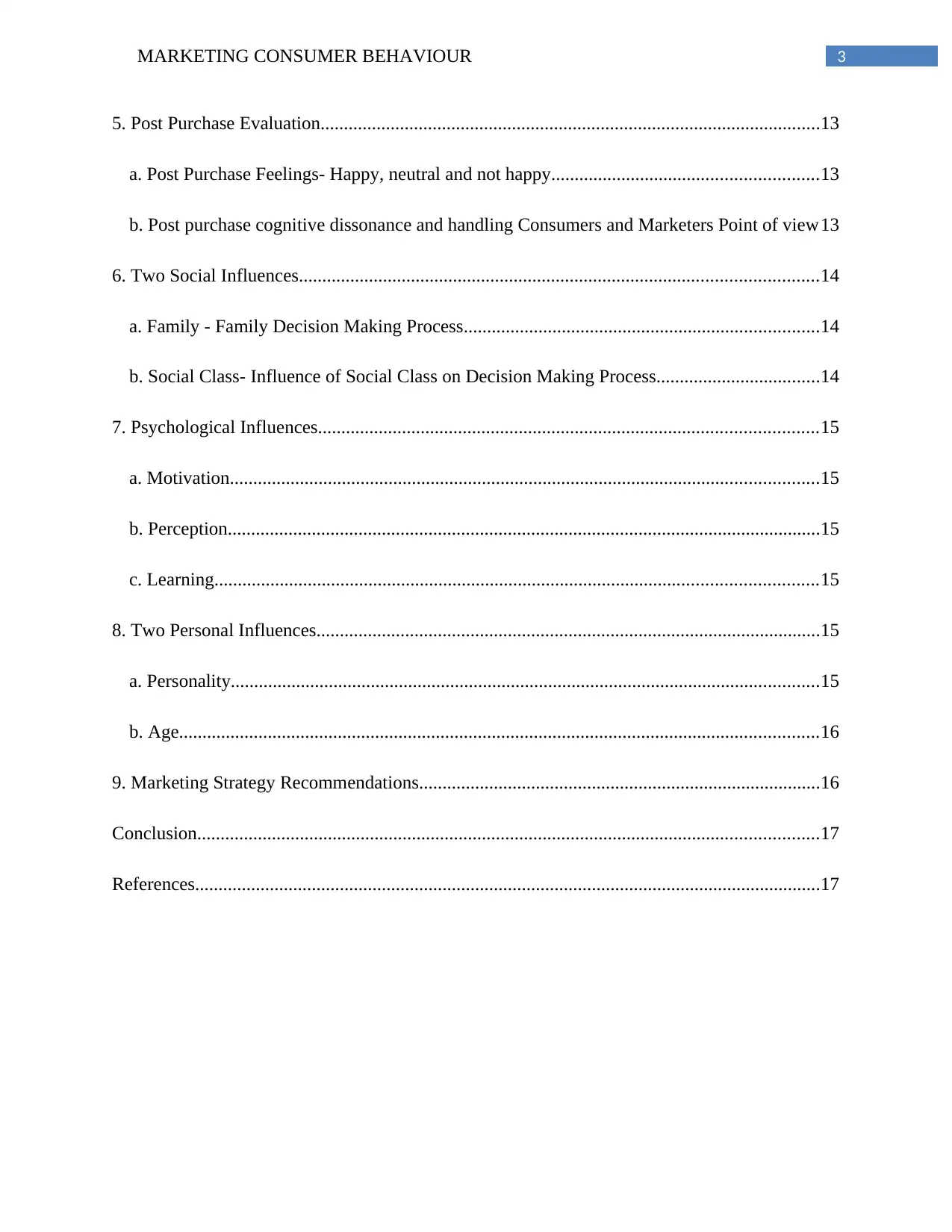
3MARKETING CONSUMER BEHAVIOUR
5. Post Purchase Evaluation...........................................................................................................13
a. Post Purchase Feelings- Happy, neutral and not happy.........................................................13
b. Post purchase cognitive dissonance and handling Consumers and Marketers Point of view13
6. Two Social Influences...............................................................................................................14
a. Family - Family Decision Making Process............................................................................14
b. Social Class- Influence of Social Class on Decision Making Process...................................14
7. Psychological Influences...........................................................................................................15
a. Motivation..............................................................................................................................15
b. Perception...............................................................................................................................15
c. Learning.................................................................................................................................15
8. Two Personal Influences............................................................................................................15
a. Personality..............................................................................................................................15
b. Age.........................................................................................................................................16
9. Marketing Strategy Recommendations......................................................................................16
Conclusion.....................................................................................................................................17
References......................................................................................................................................17
5. Post Purchase Evaluation...........................................................................................................13
a. Post Purchase Feelings- Happy, neutral and not happy.........................................................13
b. Post purchase cognitive dissonance and handling Consumers and Marketers Point of view13
6. Two Social Influences...............................................................................................................14
a. Family - Family Decision Making Process............................................................................14
b. Social Class- Influence of Social Class on Decision Making Process...................................14
7. Psychological Influences...........................................................................................................15
a. Motivation..............................................................................................................................15
b. Perception...............................................................................................................................15
c. Learning.................................................................................................................................15
8. Two Personal Influences............................................................................................................15
a. Personality..............................................................................................................................15
b. Age.........................................................................................................................................16
9. Marketing Strategy Recommendations......................................................................................16
Conclusion.....................................................................................................................................17
References......................................................................................................................................17
Paraphrase This Document
Need a fresh take? Get an instant paraphrase of this document with our AI Paraphraser
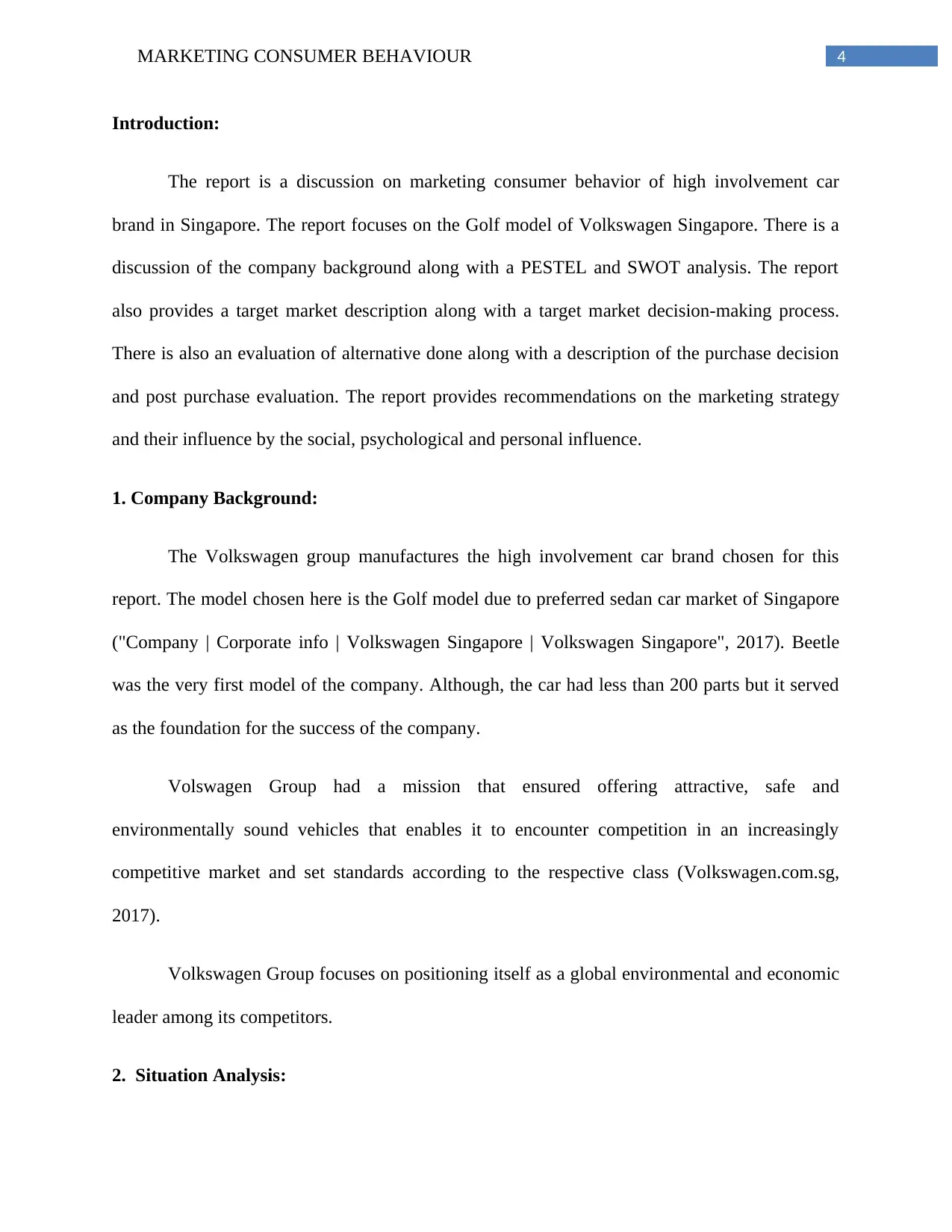
4MARKETING CONSUMER BEHAVIOUR
Introduction:
The report is a discussion on marketing consumer behavior of high involvement car
brand in Singapore. The report focuses on the Golf model of Volkswagen Singapore. There is a
discussion of the company background along with a PESTEL and SWOT analysis. The report
also provides a target market description along with a target market decision-making process.
There is also an evaluation of alternative done along with a description of the purchase decision
and post purchase evaluation. The report provides recommendations on the marketing strategy
and their influence by the social, psychological and personal influence.
1. Company Background:
The Volkswagen group manufactures the high involvement car brand chosen for this
report. The model chosen here is the Golf model due to preferred sedan car market of Singapore
("Company | Corporate info | Volkswagen Singapore | Volkswagen Singapore", 2017). Beetle
was the very first model of the company. Although, the car had less than 200 parts but it served
as the foundation for the success of the company.
Volswagen Group had a mission that ensured offering attractive, safe and
environmentally sound vehicles that enables it to encounter competition in an increasingly
competitive market and set standards according to the respective class (Volkswagen.com.sg,
2017).
Volkswagen Group focuses on positioning itself as a global environmental and economic
leader among its competitors.
2. Situation Analysis:
Introduction:
The report is a discussion on marketing consumer behavior of high involvement car
brand in Singapore. The report focuses on the Golf model of Volkswagen Singapore. There is a
discussion of the company background along with a PESTEL and SWOT analysis. The report
also provides a target market description along with a target market decision-making process.
There is also an evaluation of alternative done along with a description of the purchase decision
and post purchase evaluation. The report provides recommendations on the marketing strategy
and their influence by the social, psychological and personal influence.
1. Company Background:
The Volkswagen group manufactures the high involvement car brand chosen for this
report. The model chosen here is the Golf model due to preferred sedan car market of Singapore
("Company | Corporate info | Volkswagen Singapore | Volkswagen Singapore", 2017). Beetle
was the very first model of the company. Although, the car had less than 200 parts but it served
as the foundation for the success of the company.
Volswagen Group had a mission that ensured offering attractive, safe and
environmentally sound vehicles that enables it to encounter competition in an increasingly
competitive market and set standards according to the respective class (Volkswagen.com.sg,
2017).
Volkswagen Group focuses on positioning itself as a global environmental and economic
leader among its competitors.
2. Situation Analysis:
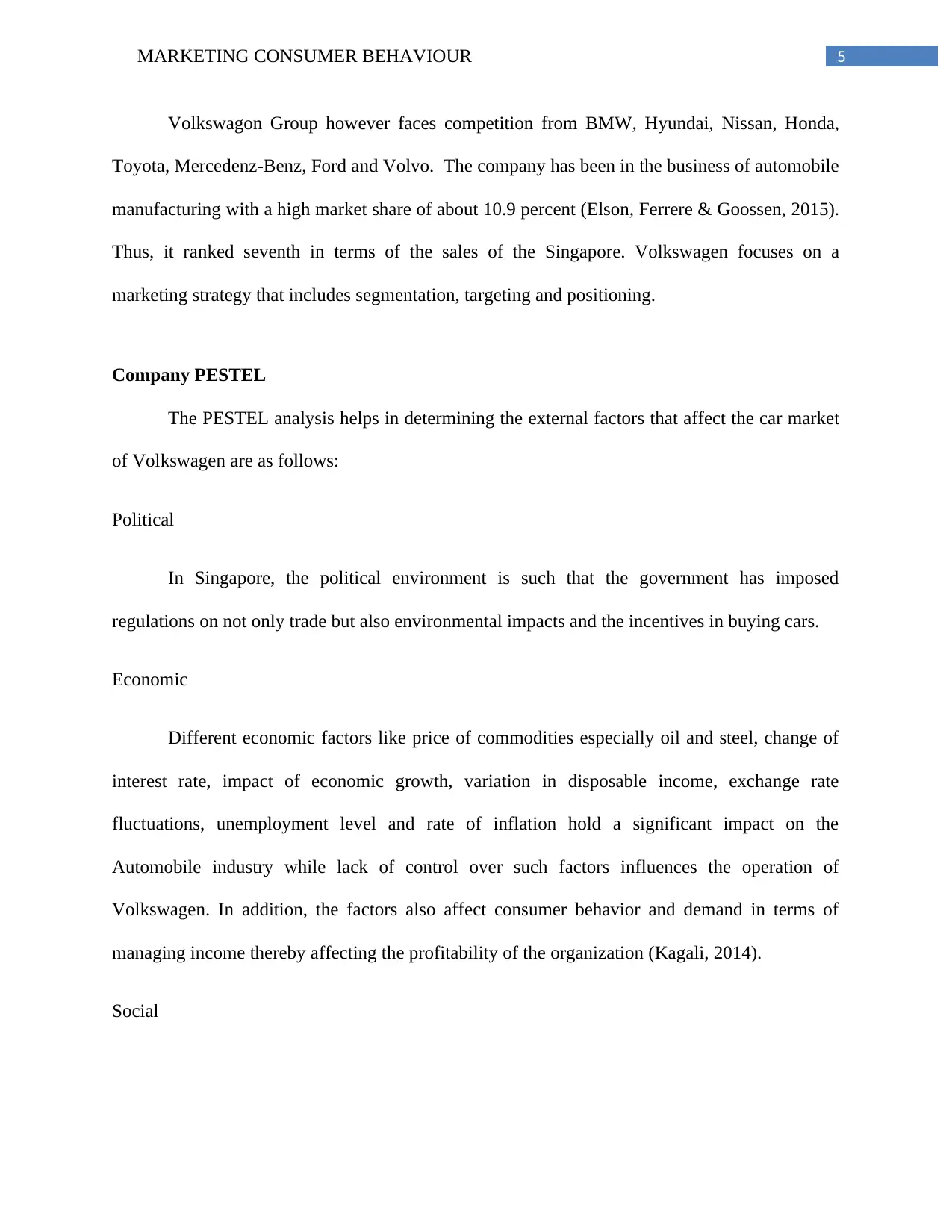
5MARKETING CONSUMER BEHAVIOUR
Volkswagon Group however faces competition from BMW, Hyundai, Nissan, Honda,
Toyota, Mercedenz-Benz, Ford and Volvo. The company has been in the business of automobile
manufacturing with a high market share of about 10.9 percent (Elson, Ferrere & Goossen, 2015).
Thus, it ranked seventh in terms of the sales of the Singapore. Volkswagen focuses on a
marketing strategy that includes segmentation, targeting and positioning.
Company PESTEL
The PESTEL analysis helps in determining the external factors that affect the car market
of Volkswagen are as follows:
Political
In Singapore, the political environment is such that the government has imposed
regulations on not only trade but also environmental impacts and the incentives in buying cars.
Economic
Different economic factors like price of commodities especially oil and steel, change of
interest rate, impact of economic growth, variation in disposable income, exchange rate
fluctuations, unemployment level and rate of inflation hold a significant impact on the
Automobile industry while lack of control over such factors influences the operation of
Volkswagen. In addition, the factors also affect consumer behavior and demand in terms of
managing income thereby affecting the profitability of the organization (Kagali, 2014).
Social
Volkswagon Group however faces competition from BMW, Hyundai, Nissan, Honda,
Toyota, Mercedenz-Benz, Ford and Volvo. The company has been in the business of automobile
manufacturing with a high market share of about 10.9 percent (Elson, Ferrere & Goossen, 2015).
Thus, it ranked seventh in terms of the sales of the Singapore. Volkswagen focuses on a
marketing strategy that includes segmentation, targeting and positioning.
Company PESTEL
The PESTEL analysis helps in determining the external factors that affect the car market
of Volkswagen are as follows:
Political
In Singapore, the political environment is such that the government has imposed
regulations on not only trade but also environmental impacts and the incentives in buying cars.
Economic
Different economic factors like price of commodities especially oil and steel, change of
interest rate, impact of economic growth, variation in disposable income, exchange rate
fluctuations, unemployment level and rate of inflation hold a significant impact on the
Automobile industry while lack of control over such factors influences the operation of
Volkswagen. In addition, the factors also affect consumer behavior and demand in terms of
managing income thereby affecting the profitability of the organization (Kagali, 2014).
Social
⊘ This is a preview!⊘
Do you want full access?
Subscribe today to unlock all pages.

Trusted by 1+ million students worldwide
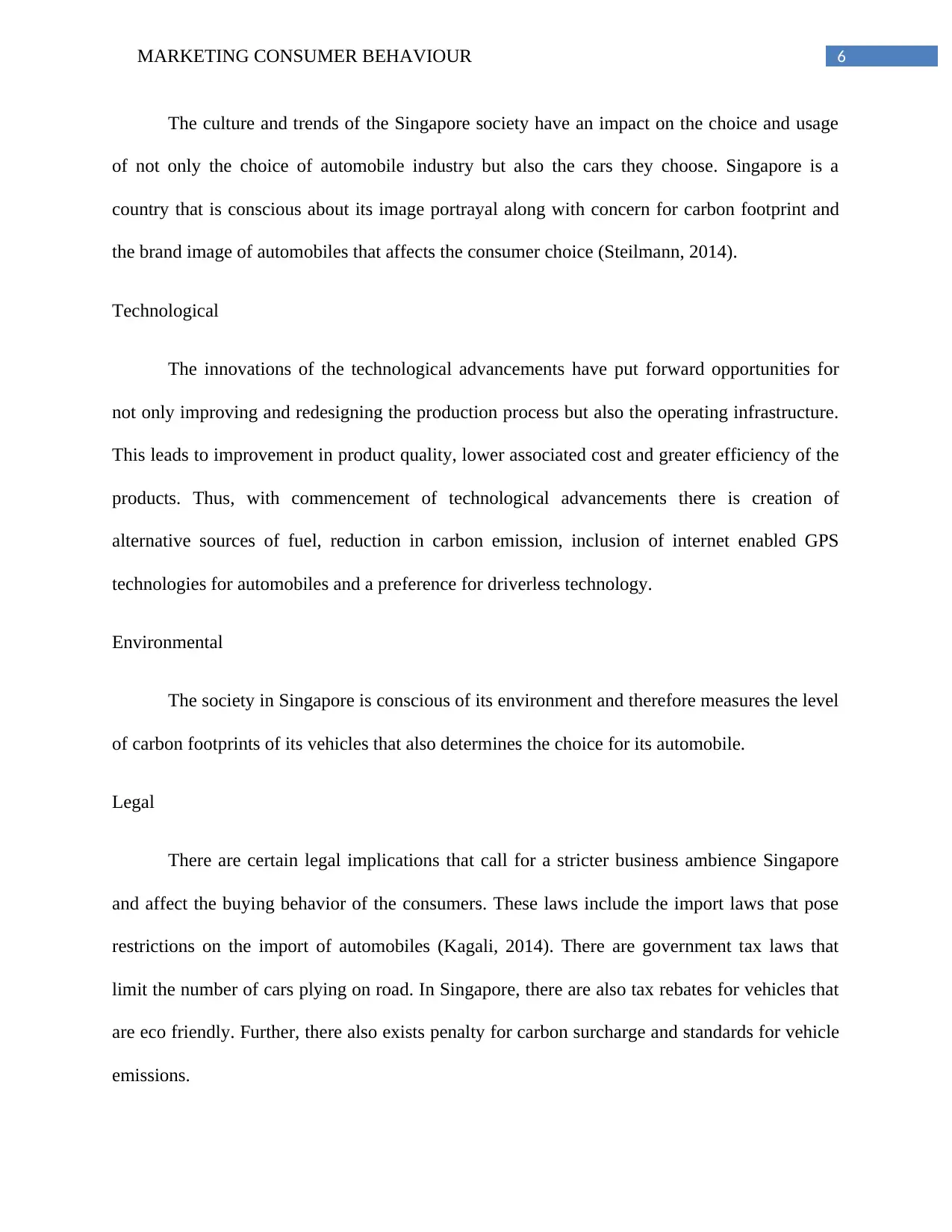
6MARKETING CONSUMER BEHAVIOUR
The culture and trends of the Singapore society have an impact on the choice and usage
of not only the choice of automobile industry but also the cars they choose. Singapore is a
country that is conscious about its image portrayal along with concern for carbon footprint and
the brand image of automobiles that affects the consumer choice (Steilmann, 2014).
Technological
The innovations of the technological advancements have put forward opportunities for
not only improving and redesigning the production process but also the operating infrastructure.
This leads to improvement in product quality, lower associated cost and greater efficiency of the
products. Thus, with commencement of technological advancements there is creation of
alternative sources of fuel, reduction in carbon emission, inclusion of internet enabled GPS
technologies for automobiles and a preference for driverless technology.
Environmental
The society in Singapore is conscious of its environment and therefore measures the level
of carbon footprints of its vehicles that also determines the choice for its automobile.
Legal
There are certain legal implications that call for a stricter business ambience Singapore
and affect the buying behavior of the consumers. These laws include the import laws that pose
restrictions on the import of automobiles (Kagali, 2014). There are government tax laws that
limit the number of cars plying on road. In Singapore, there are also tax rebates for vehicles that
are eco friendly. Further, there also exists penalty for carbon surcharge and standards for vehicle
emissions.
The culture and trends of the Singapore society have an impact on the choice and usage
of not only the choice of automobile industry but also the cars they choose. Singapore is a
country that is conscious about its image portrayal along with concern for carbon footprint and
the brand image of automobiles that affects the consumer choice (Steilmann, 2014).
Technological
The innovations of the technological advancements have put forward opportunities for
not only improving and redesigning the production process but also the operating infrastructure.
This leads to improvement in product quality, lower associated cost and greater efficiency of the
products. Thus, with commencement of technological advancements there is creation of
alternative sources of fuel, reduction in carbon emission, inclusion of internet enabled GPS
technologies for automobiles and a preference for driverless technology.
Environmental
The society in Singapore is conscious of its environment and therefore measures the level
of carbon footprints of its vehicles that also determines the choice for its automobile.
Legal
There are certain legal implications that call for a stricter business ambience Singapore
and affect the buying behavior of the consumers. These laws include the import laws that pose
restrictions on the import of automobiles (Kagali, 2014). There are government tax laws that
limit the number of cars plying on road. In Singapore, there are also tax rebates for vehicles that
are eco friendly. Further, there also exists penalty for carbon surcharge and standards for vehicle
emissions.
Paraphrase This Document
Need a fresh take? Get an instant paraphrase of this document with our AI Paraphraser
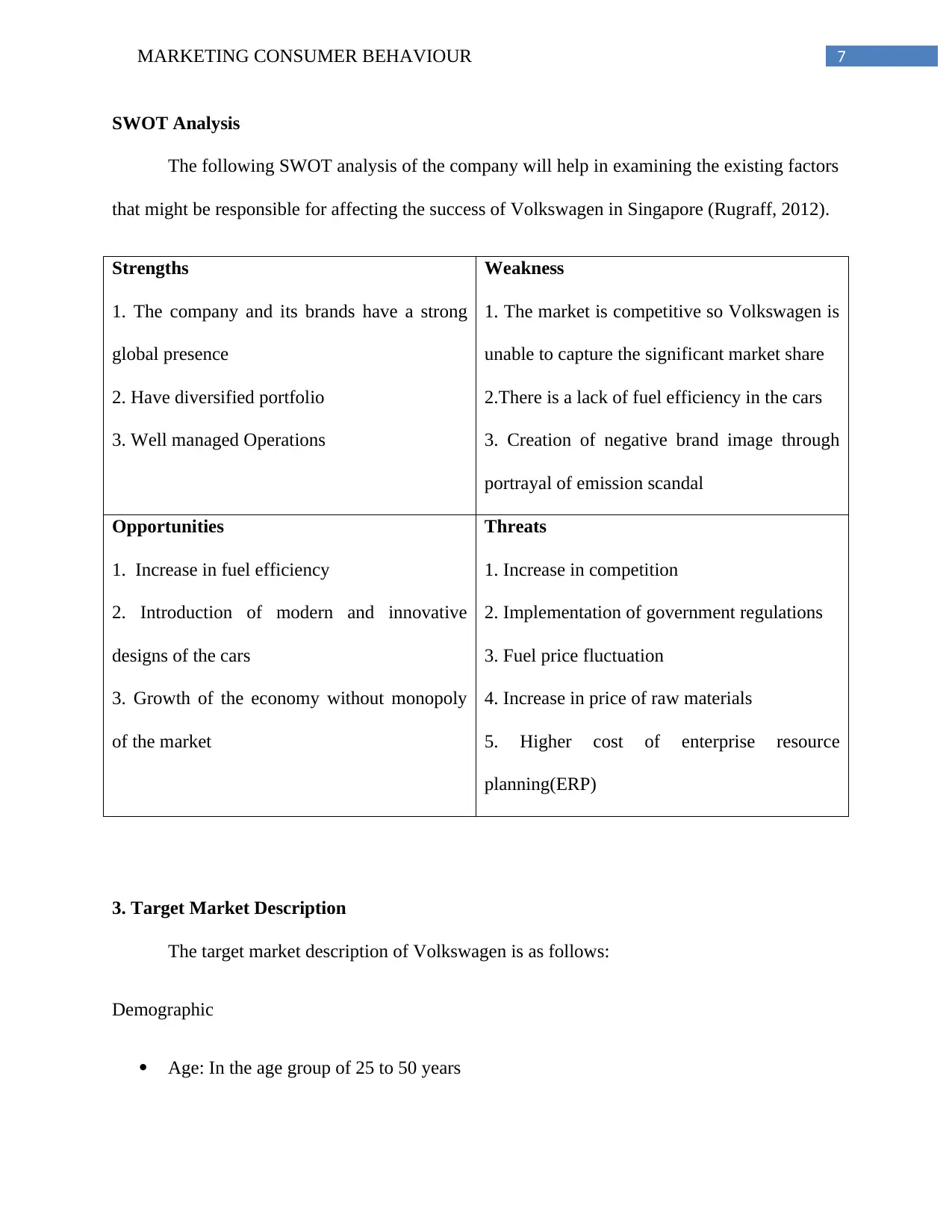
7MARKETING CONSUMER BEHAVIOUR
SWOT Analysis
The following SWOT analysis of the company will help in examining the existing factors
that might be responsible for affecting the success of Volkswagen in Singapore (Rugraff, 2012).
Strengths
1. The company and its brands have a strong
global presence
2. Have diversified portfolio
3. Well managed Operations
Weakness
1. The market is competitive so Volkswagen is
unable to capture the significant market share
2.There is a lack of fuel efficiency in the cars
3. Creation of negative brand image through
portrayal of emission scandal
Opportunities
1. Increase in fuel efficiency
2. Introduction of modern and innovative
designs of the cars
3. Growth of the economy without monopoly
of the market
Threats
1. Increase in competition
2. Implementation of government regulations
3. Fuel price fluctuation
4. Increase in price of raw materials
5. Higher cost of enterprise resource
planning(ERP)
3. Target Market Description
The target market description of Volkswagen is as follows:
Demographic
Age: In the age group of 25 to 50 years
SWOT Analysis
The following SWOT analysis of the company will help in examining the existing factors
that might be responsible for affecting the success of Volkswagen in Singapore (Rugraff, 2012).
Strengths
1. The company and its brands have a strong
global presence
2. Have diversified portfolio
3. Well managed Operations
Weakness
1. The market is competitive so Volkswagen is
unable to capture the significant market share
2.There is a lack of fuel efficiency in the cars
3. Creation of negative brand image through
portrayal of emission scandal
Opportunities
1. Increase in fuel efficiency
2. Introduction of modern and innovative
designs of the cars
3. Growth of the economy without monopoly
of the market
Threats
1. Increase in competition
2. Implementation of government regulations
3. Fuel price fluctuation
4. Increase in price of raw materials
5. Higher cost of enterprise resource
planning(ERP)
3. Target Market Description
The target market description of Volkswagen is as follows:
Demographic
Age: In the age group of 25 to 50 years
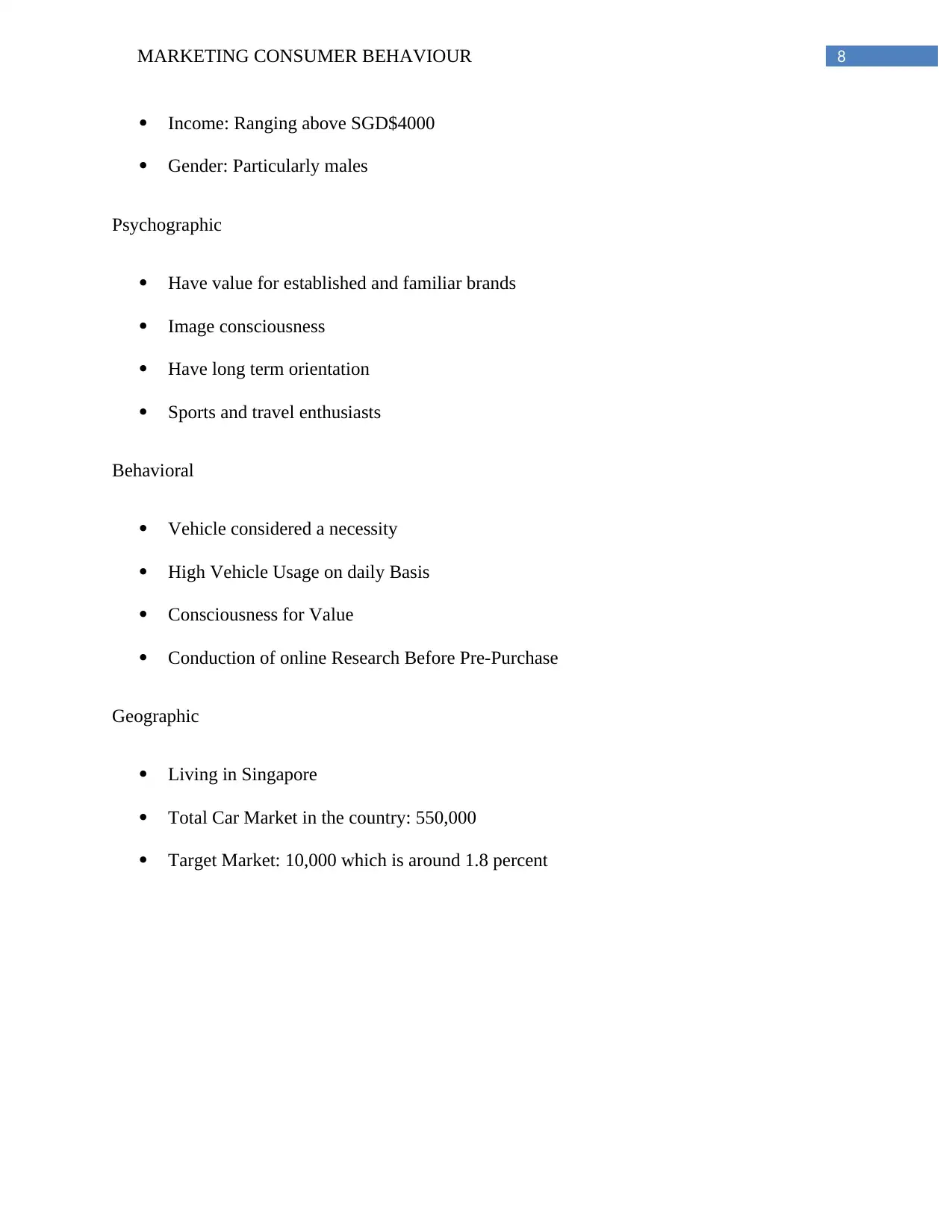
8MARKETING CONSUMER BEHAVIOUR
Income: Ranging above SGD$4000
Gender: Particularly males
Psychographic
Have value for established and familiar brands
Image consciousness
Have long term orientation
Sports and travel enthusiasts
Behavioral
Vehicle considered a necessity
High Vehicle Usage on daily Basis
Consciousness for Value
Conduction of online Research Before Pre-Purchase
Geographic
Living in Singapore
Total Car Market in the country: 550,000
Target Market: 10,000 which is around 1.8 percent
Income: Ranging above SGD$4000
Gender: Particularly males
Psychographic
Have value for established and familiar brands
Image consciousness
Have long term orientation
Sports and travel enthusiasts
Behavioral
Vehicle considered a necessity
High Vehicle Usage on daily Basis
Consciousness for Value
Conduction of online Research Before Pre-Purchase
Geographic
Living in Singapore
Total Car Market in the country: 550,000
Target Market: 10,000 which is around 1.8 percent
⊘ This is a preview!⊘
Do you want full access?
Subscribe today to unlock all pages.

Trusted by 1+ million students worldwide

9MARKETING CONSUMER BEHAVIOUR
4. Target Market Decision Making Process
1. Problem Recognition
a. Market Induced
There is encouragement from the marketers that influences the consumers to be
dissatisfied with the present situation that leads to the creation of new wants and needs.
Volkswagen tries to capture this aspect of consumer behavior by introducing new products
(Ingram et.al 2012). This arouses the interest of the customers in the newly introduced car brand.
b. New Stage in Life
Volkswagon targets the customers in the age group of 25 and above. This is a stage in the
life of a person where he forms an idea about himself. Moreover, this is a stage when people
have a stable disposal income and starts thinking of starting a family (Gurău, 2012). This stage
also makes the person brand conscious and leaves him in a position where he is most
comfortable and acts as a deciding factor for making purchase.
2. Information Search
a. Level of Risk
However, before making a purchase decision each consumer will determine the level of
risk. This risk involves technical risk, service risk, social risk, time risk, financial risk,
psychological risk, and brand and product risk (Henthorne, George & Smith, 2013).
b. Level of Product Knowledge
The information about the product is important for driving the shopping experience of the
consumers. Various websites can contribute to enhancing the level of knowledge regarding the
4. Target Market Decision Making Process
1. Problem Recognition
a. Market Induced
There is encouragement from the marketers that influences the consumers to be
dissatisfied with the present situation that leads to the creation of new wants and needs.
Volkswagen tries to capture this aspect of consumer behavior by introducing new products
(Ingram et.al 2012). This arouses the interest of the customers in the newly introduced car brand.
b. New Stage in Life
Volkswagon targets the customers in the age group of 25 and above. This is a stage in the
life of a person where he forms an idea about himself. Moreover, this is a stage when people
have a stable disposal income and starts thinking of starting a family (Gurău, 2012). This stage
also makes the person brand conscious and leaves him in a position where he is most
comfortable and acts as a deciding factor for making purchase.
2. Information Search
a. Level of Risk
However, before making a purchase decision each consumer will determine the level of
risk. This risk involves technical risk, service risk, social risk, time risk, financial risk,
psychological risk, and brand and product risk (Henthorne, George & Smith, 2013).
b. Level of Product Knowledge
The information about the product is important for driving the shopping experience of the
consumers. Various websites can contribute to enhancing the level of knowledge regarding the
Paraphrase This Document
Need a fresh take? Get an instant paraphrase of this document with our AI Paraphraser
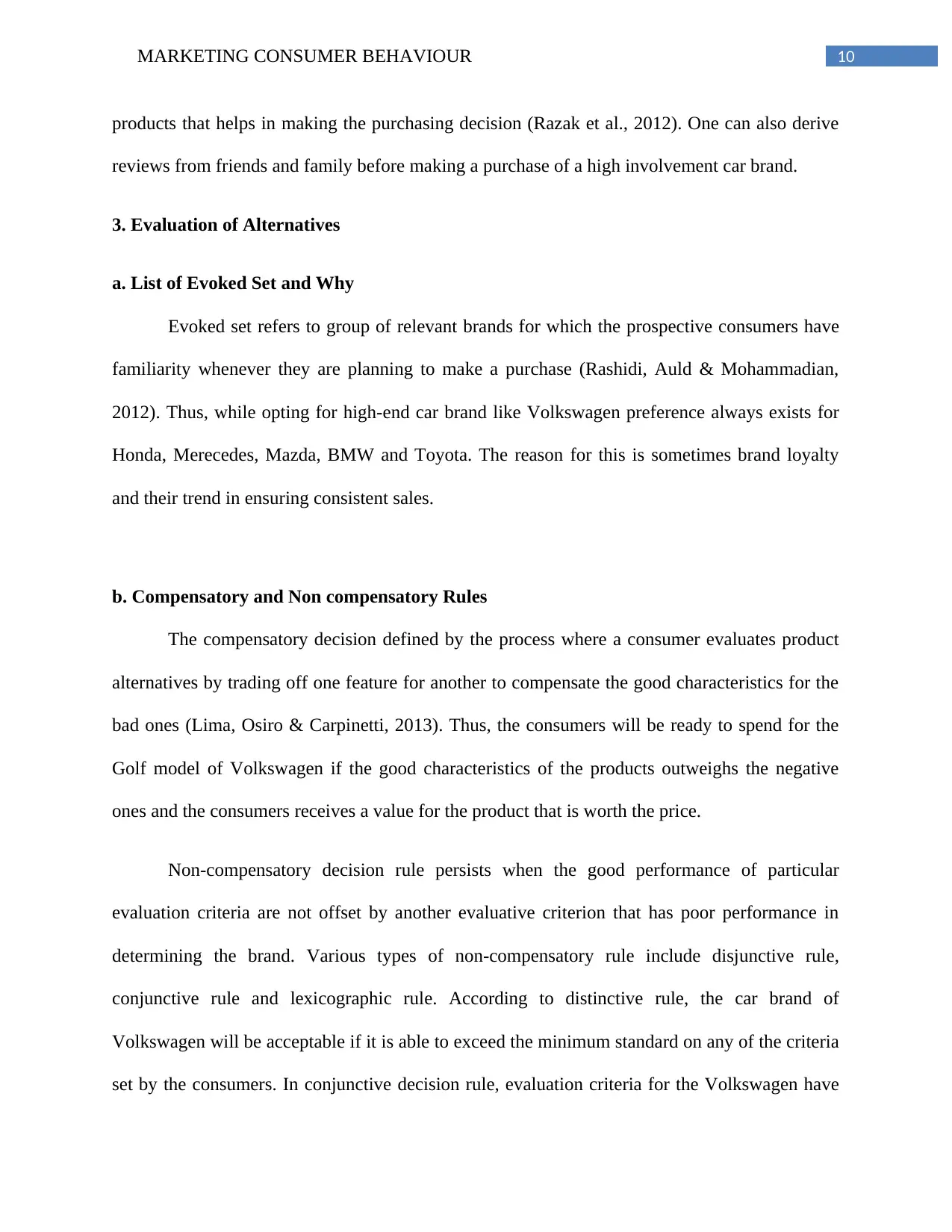
10MARKETING CONSUMER BEHAVIOUR
products that helps in making the purchasing decision (Razak et al., 2012). One can also derive
reviews from friends and family before making a purchase of a high involvement car brand.
3. Evaluation of Alternatives
a. List of Evoked Set and Why
Evoked set refers to group of relevant brands for which the prospective consumers have
familiarity whenever they are planning to make a purchase (Rashidi, Auld & Mohammadian,
2012). Thus, while opting for high-end car brand like Volkswagen preference always exists for
Honda, Merecedes, Mazda, BMW and Toyota. The reason for this is sometimes brand loyalty
and their trend in ensuring consistent sales.
b. Compensatory and Non compensatory Rules
The compensatory decision defined by the process where a consumer evaluates product
alternatives by trading off one feature for another to compensate the good characteristics for the
bad ones (Lima, Osiro & Carpinetti, 2013). Thus, the consumers will be ready to spend for the
Golf model of Volkswagen if the good characteristics of the products outweighs the negative
ones and the consumers receives a value for the product that is worth the price.
Non-compensatory decision rule persists when the good performance of particular
evaluation criteria are not offset by another evaluative criterion that has poor performance in
determining the brand. Various types of non-compensatory rule include disjunctive rule,
conjunctive rule and lexicographic rule. According to distinctive rule, the car brand of
Volkswagen will be acceptable if it is able to exceed the minimum standard on any of the criteria
set by the consumers. In conjunctive decision rule, evaluation criteria for the Volkswagen have
products that helps in making the purchasing decision (Razak et al., 2012). One can also derive
reviews from friends and family before making a purchase of a high involvement car brand.
3. Evaluation of Alternatives
a. List of Evoked Set and Why
Evoked set refers to group of relevant brands for which the prospective consumers have
familiarity whenever they are planning to make a purchase (Rashidi, Auld & Mohammadian,
2012). Thus, while opting for high-end car brand like Volkswagen preference always exists for
Honda, Merecedes, Mazda, BMW and Toyota. The reason for this is sometimes brand loyalty
and their trend in ensuring consistent sales.
b. Compensatory and Non compensatory Rules
The compensatory decision defined by the process where a consumer evaluates product
alternatives by trading off one feature for another to compensate the good characteristics for the
bad ones (Lima, Osiro & Carpinetti, 2013). Thus, the consumers will be ready to spend for the
Golf model of Volkswagen if the good characteristics of the products outweighs the negative
ones and the consumers receives a value for the product that is worth the price.
Non-compensatory decision rule persists when the good performance of particular
evaluation criteria are not offset by another evaluative criterion that has poor performance in
determining the brand. Various types of non-compensatory rule include disjunctive rule,
conjunctive rule and lexicographic rule. According to distinctive rule, the car brand of
Volkswagen will be acceptable if it is able to exceed the minimum standard on any of the criteria
set by the consumers. In conjunctive decision rule, evaluation criteria for the Volkswagen have
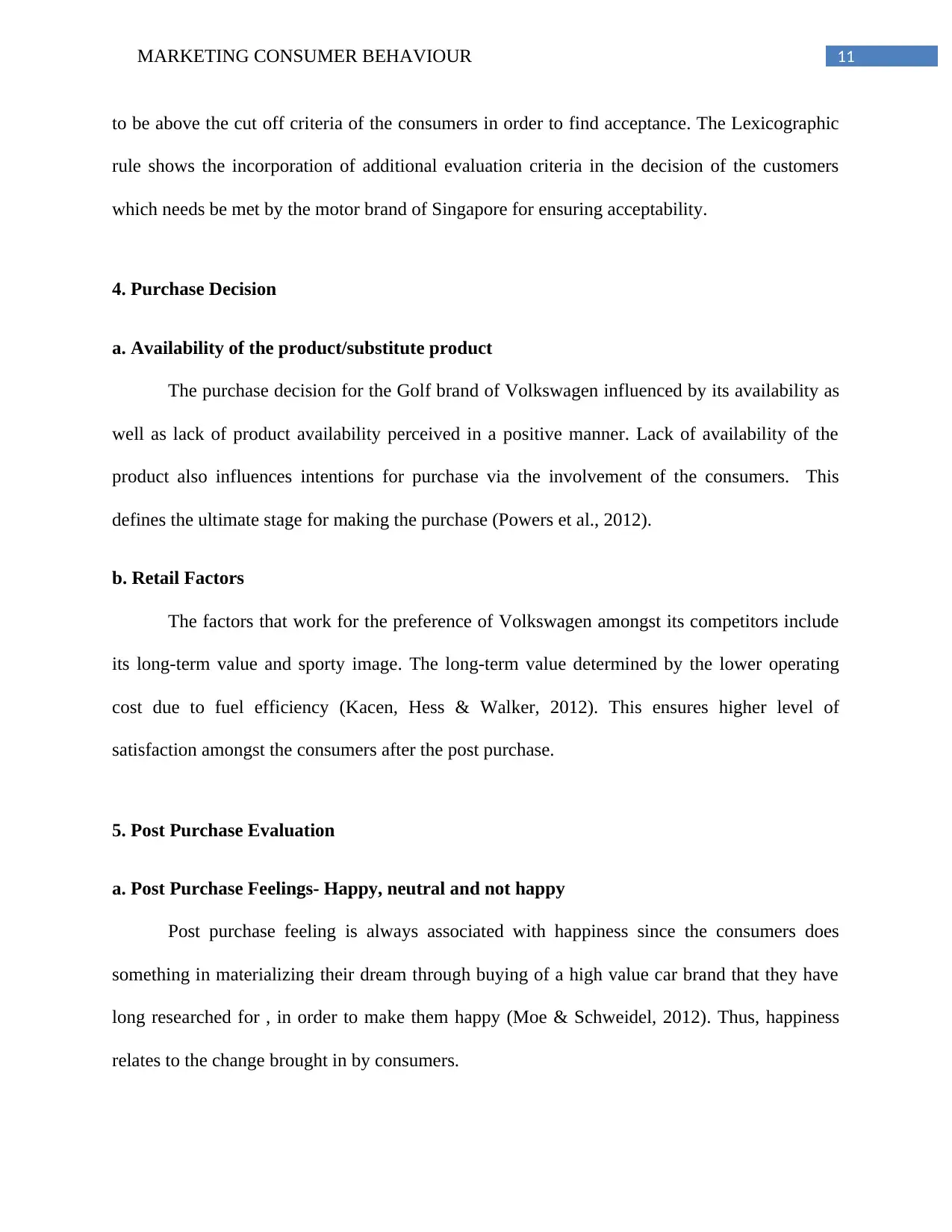
11MARKETING CONSUMER BEHAVIOUR
to be above the cut off criteria of the consumers in order to find acceptance. The Lexicographic
rule shows the incorporation of additional evaluation criteria in the decision of the customers
which needs be met by the motor brand of Singapore for ensuring acceptability.
4. Purchase Decision
a. Availability of the product/substitute product
The purchase decision for the Golf brand of Volkswagen influenced by its availability as
well as lack of product availability perceived in a positive manner. Lack of availability of the
product also influences intentions for purchase via the involvement of the consumers. This
defines the ultimate stage for making the purchase (Powers et al., 2012).
b. Retail Factors
The factors that work for the preference of Volkswagen amongst its competitors include
its long-term value and sporty image. The long-term value determined by the lower operating
cost due to fuel efficiency (Kacen, Hess & Walker, 2012). This ensures higher level of
satisfaction amongst the consumers after the post purchase.
5. Post Purchase Evaluation
a. Post Purchase Feelings- Happy, neutral and not happy
Post purchase feeling is always associated with happiness since the consumers does
something in materializing their dream through buying of a high value car brand that they have
long researched for , in order to make them happy (Moe & Schweidel, 2012). Thus, happiness
relates to the change brought in by consumers.
to be above the cut off criteria of the consumers in order to find acceptance. The Lexicographic
rule shows the incorporation of additional evaluation criteria in the decision of the customers
which needs be met by the motor brand of Singapore for ensuring acceptability.
4. Purchase Decision
a. Availability of the product/substitute product
The purchase decision for the Golf brand of Volkswagen influenced by its availability as
well as lack of product availability perceived in a positive manner. Lack of availability of the
product also influences intentions for purchase via the involvement of the consumers. This
defines the ultimate stage for making the purchase (Powers et al., 2012).
b. Retail Factors
The factors that work for the preference of Volkswagen amongst its competitors include
its long-term value and sporty image. The long-term value determined by the lower operating
cost due to fuel efficiency (Kacen, Hess & Walker, 2012). This ensures higher level of
satisfaction amongst the consumers after the post purchase.
5. Post Purchase Evaluation
a. Post Purchase Feelings- Happy, neutral and not happy
Post purchase feeling is always associated with happiness since the consumers does
something in materializing their dream through buying of a high value car brand that they have
long researched for , in order to make them happy (Moe & Schweidel, 2012). Thus, happiness
relates to the change brought in by consumers.
⊘ This is a preview!⊘
Do you want full access?
Subscribe today to unlock all pages.

Trusted by 1+ million students worldwide
1 out of 19
Related Documents
Your All-in-One AI-Powered Toolkit for Academic Success.
+13062052269
info@desklib.com
Available 24*7 on WhatsApp / Email
![[object Object]](/_next/static/media/star-bottom.7253800d.svg)
Unlock your academic potential
Copyright © 2020–2025 A2Z Services. All Rights Reserved. Developed and managed by ZUCOL.





